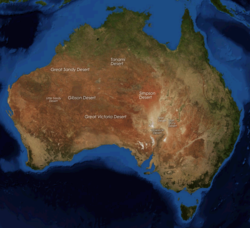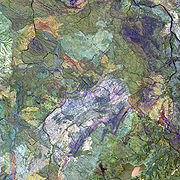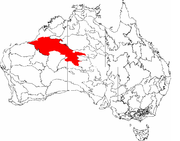
Great Sandy Desert
Encyclopedia

- There is another desert called the "Great Sandy DesertHigh Desert (Oregon)The Oregon High Desert is a region of the U.S. state of Oregon, located east of the Cascade Range and south of the Blue Mountains, in the central and eastern parts of the state. Divided into a southern region and a northern region, the desert covers most of five Oregon counties and averages above...
" in OregonOregonOregon is a state in the Pacific Northwest region of the United States. It is located on the Pacific coast, with Washington to the north, California to the south, Nevada on the southeast and Idaho to the east. The Columbia and Snake rivers delineate much of Oregon's northern and eastern...
, USUnited StatesThe United States of America is a federal constitutional republic comprising fifty states and a federal district...
.
The Great Sandy Desert is a desert located in the North West of Western Australia
Western Australia
Western Australia is a state of Australia, occupying the entire western third of the Australian continent. It is bounded by the Indian Ocean to the north and west, the Great Australian Bight and Indian Ocean to the south, the Northern Territory to the north-east and South Australia to the south-east...
straddling the Pilbara and southern Kimberley regions
Regions of Western Australia
Regionalisations of Western Australia are systems by which Western Australia is divided into distinct geographic regions. The most commonly known regionalisation is the governmental division of the state into regions for economic development purposes, of which there are nine.Other regionalisations...
. It is the second largest desert in Australia after the Great Victoria Desert
Great Victoria Desert
The Great Victoria Desert is a barren and sparsely populated desert area of southern Australia.-Location and description:The Great Victoria is the biggest desert in Australia and consists of many small sandhills, grassland plains, areas with a closely packed surface of pebbles and salt lakes...
and encompasses an area of 284993 square kilometres (110,036 sq mi)
The Gibson Desert
Gibson Desert
The Gibson Desert covers a large dry area in the state of Western Australia and is still largely in an almost "pristine" state. It is about in size, making it the 5th largest desert in Australia, after the Great Sandy, Great Victoria, Tanami and Simpson deserts.-Location and description:The Gibson...
lies to the south and the Tanami Desert
Tanami Desert
The Tanami Desert is a desert in northern Australia situated in the Northern Territory. It has a rocky terrain with small hills. The Tanami was the Northern Territory's final frontier and was not fully explored until well into the twentieth century...
lies to the East of the Great Sandy Desert.
Geomorphology

Erg (landform)
An erg is a broad, flat area of desert covered with wind-swept sand with little or no vegetative cover. The term takes its name from the Arabic word ʿarq , meaning "dune field"...
, often consisting of longitudinal dune
Dune
In physical geography, a dune is a hill of sand built by wind. Dunes occur in different forms and sizes, formed by interaction with the wind. Most kinds of dunes are longer on the windward side where the sand is pushed up the dune and have a shorter "slip face" in the lee of the wind...
s. The Wolfe Creek
Wolfe Creek crater
Wolfe Creek Crater is a well-preserved meteorite impact crater in Western Australia., It is accessed via the Tanami Road south of the town of Halls Creek...
meteorite impact crater is located in the northeast.
The region is sparsely populated. The main populations consist of Indigenous Australian communities and mining centers. The aboriginal people of the desert fall into two main groups the Martu
Martu (Indigenous Australian)
Mardu are an Australian Aboriginal people of the Western Desert. Their lands include the Percival Lakes and Pilbara regions in Western Australia...
in the west and the Pintupi
Pintupi
Pintupi refers to an Australian Aboriginal group who are part of the Western Desert cultural group and whose homeland is in the area west of Lake MacDonald and Lake Mackay in Western Australia. These people moved into the Aboriginal communities of Papunya and Haasts Bluff in the west of the...
in the east. Linguistically, they are speakers of multiple Western Desert Language
Western Desert Language
Western Desert Language is the name used to refer to an otherwise un-named Australian Aboriginal language. It is one of the Wati languages of the large Southwest branch of the Pama–Nyungan family.-Location and list of communities:...
s. Many of these indigenous people were forcibly removed from their lands during the 20th century and relocated to settlements such as Papunya
Papunya, Northern Territory
Papunya is a small Indigenous Australian community of about 299 people roughly 240 km northwest of Alice Springs in the Northern Territory, Australia...
in the Northern Territory. In recent years, some of the original inhabitants have returned.
Young Indigenous adults from the Great Sandy Desert region travel to and work in the Wilurarra Creative programs to maintain and develop their culture.
Climate
Rain fall is low throughout the coast and far north. Areas near the Kimberley have an average rainfall that exceeds 300 mm (11.8 in), but the rainfall is patchy. Many drought years end with a monsoon cloud mass or tropical cycloneTropical cyclone
A tropical cyclone is a storm system characterized by a large low-pressure center and numerous thunderstorms that produce strong winds and heavy rain. Tropical cyclones strengthen when water evaporated from the ocean is released as the saturated air rises, resulting in condensation of water vapor...
. Like many of Australia's deserts, rainfall does seem high by desert
Desert
A desert is a landscape or region that receives an extremely low amount of precipitation, less than enough to support growth of most plants. Most deserts have an average annual precipitation of less than...
standards, because even in the driest parts rainfalls rarely drop below 250 mm (9.8 in). A massive evaporation rate makes up for the higher than normal desert rainfall. This region is one which gives rise to the heat lows which help drive the NW monsoon. Almost all rain comes from monsoon thunderstorms, or the occasional tropical cyclone rain depression.
On average for most of the area, there are about 20-30 days where thunderstorms form. However, in the north bordering the Kimberley, 30-40 per year is the average.
Summer daytime temperatures are some of the hottest in Australia. The range on the northern border near the Kimberley at Halls Creek
Halls Creek, Western Australia
Halls Creek is a small town situated in the East Kimberley region of Western Australia. It is located between the towns of Fitzroy Crossing and Turkey Creek on the Great Northern Highway...
is around 37 to 38 °C (98.6 to 100.4 F), but this would be indicative of the low end of the range. Regions further south average 38 to 42 °C (100.4 to 107.6 F) except when monsoonal cloud cover is active. Several people have died in this region after their vehicles have broken down on remote tracks. Winter is short and warm; temperatures range from 25 to 30 °C (77 to 86 F) and by late August it is hot again.
Frost does not occur in most of the area. The regions bordering the Gibson Desert in the far south east may record a light frost or two every year. Away from the coast winter nights can still be chilly in comparison to the warm days.
Economy
Indigneous Art is a huge industry in central Australia. Mines, most importantly the TelferTelfer, Western Australia
Telfer is a minesite in the Pilbara region of Western Australia, within the Great Sandy Desert. Telfer was previously the state's most isolated town, located north-east of the state capital Perth...
gold mine and Nifty copper mine, and cattle stations are found in the far west. Telfer is one of the largest gold mines in Australia. The undeveloped Kintyre Uranium Deposit
Kintyre uranium deposit
The Kintyre uranium project is located 60 km south of the Telfer gold mine and 260 km northeast of Newman at the western edge of the Great Sandy Desert in the East Pilbara region of Western Australia.-History:...
lies south of Telfer.
Fauna and Flora
The vegetation of the Great Sandy Desert is dominated by spinifexTriodia (plant genus)
Triodia is a large genus of hummock-forming grass endemic to Australia; they are commonly known as spinifex, although they are not a part of the coastal genus Spinifex. There are currently 64 recognised species...
.
Animals occurring in the region include feral camels
Australian feral camel
Thousands of the two main species of Australian feral camels, mostly dromedaries but also some bactrian camels, were imported into Australia during the 19th century for transport and construction as part of the colonisation of the central and western parts of Australia. Motorised transport replaced...
, dingo
Dingo
The Australian Dingo or Warrigal is a free-roaming wild dog unique to the continent of Australia, mainly found in the outback. Its original ancestors are thought to have arrived with humans from southeast Asia thousands of years ago, when dogs were still relatively undomesticated and closer to...
s, goanna
Goanna
Goanna is the name used to refer to any number of Australian monitor lizards of the genus Varanus, as well as to certain species from Southeast Asia.There are around 30 species of goanna, 25 of which are found in Australia...
s (including the large Perentie
Perentie
The Perentie is the largest monitor lizard or goanna native to Australia, and fourth largest lizard on earth, after the Komodo Dragon, crocodile monitor and the water monitor...
) and numerous species of lizard and birds. Other animal inhabitants include Bilbies
Bilby
Bilbies are desert-dwelling marsupial omnivores; they are members of the order Peramelemorphia. Before European colonisation of Australia, there were two species. One became extinct in the 1950s; the other survives but remains endangered....
, Mulgara
Mulgara
Mulgaras are the two species in the genus Dasycercus. They are marsupial carnivores, closely related to the Tasmanian Devil and the quolls, that live in deserts and spinifex bush of central Australia. They are 12.5–22 cm long with a 7–13 cm tail. They are nocturnal but occasionally...
, Marsupial mole
Marsupial mole
Marsupial moles is a family of marsupials of the order Notoryctemorphia, consisting of only two extant species:* Notoryctes typhlops * Notoryctes caurinus ...
, Rufous Hare-wallaby
Rufous Hare-wallaby
The rufous hare-wallaby , also known as the Mala, is a small macropod found in Australia. It was formerly widely distributed across the western half of the continent but is now confined to Bernier Island and Dorre Island Islands off Western Australia...
, Thorny Devil
Thorny Devil
Thorny Devil is an Australian lizard. It is also known as the Thorny Dragon, Mountain Devil, Thorny Lizard, or the Moloch and is the sole species of genus Moloch....
s, Bearded Dragons, and the Red Kangaroo
Red Kangaroo
The Red Kangaroo is the largest of all kangaroos, the largest mammal native to Australia, and the largest surviving marsupial. It is found across mainland Australia, avoiding only the more fertile areas in the south, the east coast, and the northern rainforests.-Description:This species is a very...
.
Some of the bird-life found wihin the desert include the rare Alexandra's Parrot, the Mulga Parrot
Mulga Parrot
The Mulga Parrot , also known as the Many-coloured Parrot, is endemic in arid scrublands and lightly timbered grasslands in the interior of southern Australia.-Taxonomy:...
and the Scarlet-chested Parrot
Scarlet-chested Parrot
The Scarlet-chested Parrot , known alternately as Scarlet-breasted parrot, Orange-throated parrot or Splendid parrot, is a parrot endemic to central South Australia and inland southern Western Australia...
.

Interim Biogeographic Regionalisation for Australia
The Interim Biogeographic Regionalisation for Australia is a biogeographic regionalisation of Australia developed by the Australian Government's Department of the Environment, Water, Heritage and the Arts...
(IBRA) region.
History
The first European to cross the desert was Peter WarburtonPeter Warburton
Colonel Peter Egerton Warburton CMG was an English explorer who made one particularly daring expedition from Adelaide to cross the centre of Australia to the coast of Western Australia via Alice Springs in 1872.The younger brother of Rowland Egerton-Warburton, Warburton was educated at home and...
. He made the journey from Alice Springs
Alice Springs, Northern Territory
Alice Springs is the second largest town in the Northern Territory of Australia. Popularly known as "the Alice" or simply "Alice", Alice Springs is situated in the geographic centre of Australia near the southern border of the Northern Territory...
leaving in April 1873 and arriving at De Grey Station
Station (Australian agriculture)
Station is the term for a large Australian landholding used for livestock production. It corresponds to the North American term ranch or South American estancia...
in January 1874. Warburton arrived in a starved condition and blind in one eye. He attributed his survival to his Aboriginal companion Charley.
The historic Canning Stock Route
Canning Stock Route
The Canning Stock Route is one of the toughest and most remote tracks in the world. It runs to Halls Creek from Wiluna, both in Western Australia. With a total distance of around it is also the longest historic stock route in the world...
traverses the southeastern portions of the Great Sandy Desert. Indigenous people were forcibly removed from the area due to Blue Streak missile
Blue Streak missile
The Blue Streak missile was a British medium range ballistic missile . The Operational Requirement for the missile was issued in 1955 and the design was complete by 1957...
tests in the 1950s.
Further reading
- Burbidge, A.A. and N.L. McKenzie. (editors)Wildlife of the Great Sandy Desert, Western Australia Perth, W.A. : Western Australian Wildlife Research Centre [and] Dept. of Fisheries and Wildlife, 1983. ISBN 0-7244-9307-7
- Thackway, R and I D Cresswell (1995) An interim biogeographic regionalisation for Australia: a framework for setting priorities in the National Reserves System Cooperative Program Version 4.0 Canberra: Australian Nature Conservation Agency, Reserve Systems Unit, 1995. ISBN 0642213712

